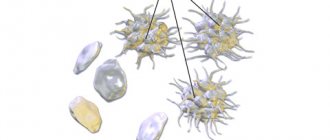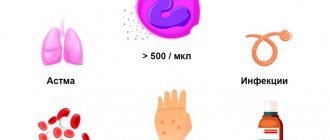General information
Platelets are granulocytic blood cells without a biconvex nucleus, formed from plasma cells of the bone marrow. They are presented in different forms - young, adult and mature. The diameter is directly proportional to age: 2-4 microns. Platelets contain granules that create blood clotting proteins, lytic enzymes, phosphatase and cathepsin, create serotonin, calcium ions and ATP, and contain lysosomal enzymes.
One of the most important functions of blood platelets is participation in blood clotting (primary hemostasis).
Platelets bind clotting factors, making blood clots thicker. As a rule, in an inactive state, when the vessel wall is damaged, platelets are directed to the damaged area. Thanks to the pseudopods located on the surface of the body, they are attached to each other and the vascular wall, forming a blood clot, which is an excellent barrier to bleeding. In the active state, platelets are able to change the shape of the body, due to which they increase their area, and this allows them to completely close the damage.
In addition, platelets are able to protect the body from foreign bodies by catching them with the help of pseudopods, and then digesting them with the help of the enzyme lysocine, which is formed from platelet factors (thrombin, thromboxane), from platelet granules. Thus, platelets are important for the immune response, being “killer” cells for foreign agents entering the body.
Blood plates serve as a storage site for serotonin, providing antitumor and radioprotective effects.
Thus, a violation of the number of platelets leads to inhibition of their functions, this certainly leads to disruption of the body’s activity and entails negative symptoms.
Normal platelet count in blood
The number of platelets in the body should normally vary from 180 to 320*10^9 for women and from 200 to 400*10^9 for men per liter of blood. Moreover, the number of platelets in women can change during menstruation to 75 * 10^9 per liter of blood, can decrease in the third trimester in pregnant women and, regardless of gender, increase in response to an inflammatory reaction, which seems to be a physiological norm and is not a deviation, without carrying negative symptoms.
In children, the normal platelet count depends directly on the age of the child. For a newborn, the norm will be 100-420*10^9 per liter of blood, and at two weeks of age and up to a year it is 150-350*10^9 per liter of blood. Up to five years, the amount changes slightly to 180-350*10^9 per liter of blood. By the age of seven, the norm reaches 180-450*10^9 per liter of blood.
For prevention, you need to take a blood test at least once a year in order to identify a possible pathology as early as possible and begin its treatment as soon as possible at an early stage, before the development of a severe clinical condition. If a deviation is detected, a blood test is performed more often.
They live in the body for only 9-10 days, after which they are renewed, destroyed in the liver or spleen and re-proliferate in the bone marrow.
Online consultation with infectious disease specialist, allergist-immunologist Natalia Nikolaevna Gordienko
Cost of online consultation: 3500 rubles
Online consultation
During the consultation, you will be able to voice your problem, the doctor will clarify the situation, interpret the tests, answer your questions and give the necessary recommendations.
Types of thrombocytopenia
Pathology is divided into several types. They are classified according to severity and prognosis for the life of the bleating person. Whether the patient needs hospitalization and, in principle, treatment depends on the type of disease diagnosed. Types of thrombocytopenia:
- Mild degree
. The PLT level remains at 50-150 thousand in 1 microliter of plasma. These indicators are considered acceptable for normal blood clotting, so bleeding and hemorrhage do not occur in this case. There is no need to treat the pathology. It is only recommended to normalize your lifestyle and undergo examination every six months. - Medium severity
. The indicators remain at around 20-50 thousand in 1 microliter of blood. The patient experiences bruising, and women may experience heavy periods. Treatment will be required if bleeding becomes regular. People who lead an active lifestyle are also treated. For example, professional athletes.
With severe thrombocytopenia, women and men develop spontaneous bleeding from the nose, oral mucosa, and vagina. Patients may observe the appearance of plasma clots in the stool and urine. In this case, urgent hospitalization is required to prevent the possibility of hemorrhage in the brain or retina.
Causes of low platelet count in blood test
A decrease in the number of platelets in a general blood test below normal to 150*10^9 per liter of blood and below is a pathological condition and is called “thrombocytopenia”. Since this is a condition, not a disease, it only characterizes, being a symptom of a specific disease.
There can be many reasons for a decrease in platelets, and they are all different from each other, so it can sometimes be very difficult to name one at once.
The main causes of thrombocytopenia are:
- Increased platelet destruction.
- Increased platelet consumption.
- Insufficient platelet production.
These three conditions can be the result of an inherited condition in which enzyme activity is impaired, but more often it is an acquired condition due to:
- Suppression of bone marrow activity.
- Hemoblastosis (tumor disease of hematopoietic or lymphoid tissue).
- Disseminated vascular coagulation syndrome (due to various bacterial infections or brain injury).
- Vitamin B12 deficiency.
- Folic acid deficiency.
- Hypersplenism syndrome (an increase in the size of the spleen, as well as an increase in the destruction of blood cells).
- Hemorrhagic diathesis (increased bleeding).
- Immune thrombocytopenia.
- Thrombocytopenic purpura.
- Leukemia (malignant disease of the bone marrow, otherwise called blood cancer).
- Paroxysmal nocturnal or cold hemoglobinuria.
- Collagenosis (connective tissue damage).
Additional reasons for a decrease in platelets in the blood may also be:
- Violation of medication regimen (vancomycin, heparin, sulfamethoxazole, drugs for the treatment of diabetes mellitus).
- Use of chemotherapy drugs.
- Massive blood transfusion.
- Cirrhosis of the liver.
- Myelofibrosis.
- Hepatitis C virus.
- Human immunodeficiency virus (HIV).
- Epstein-Barr virus (infectious mononucleosis).
- Hyperthyroidism.
- Hypothyroidism.
- Hemolytic-uremic syndrome.
- Alcoholism.
Consequences of low platelet count
In a state of low platelet count, disorders subsequently develop, which include frequent bleeding (menstrual and nosebleeds), while the bleeding time increases significantly and becomes difficult to stop. Sudden gum bleeding may develop (not everyone does). Blood clots may be found in urine or stool. Petechiae (red dots resulting from damage to the capillary wall) appear on the skin of the lower extremities, most often the legs. Even minimal damage leads to the formation of ecchymoses (bruises), when normally a bruise would not appear.
The severity of symptoms directly depends on the platelet count. The fewer platelets, the more severe the clinic. If the platelet count is very low, internal bleeding into the digestive tract or even bleeding into the brain may occur.
Even in the presence of a mild clinic, it is recommended to consult a general practitioner in order to prevent this condition.
Normal values
The norm for this indicator varies from 7.5 to 11 fL. The histogram allows you to estimate the number of platelets of different sizes. Normally, the content of mature cells should occupy 90% of the total platelet mass, young - no more than 0.8%, degenerative - 0.2%, old - 5.6%. In this case, the predominance of immature elements shifts the histogram to the left, and the predominant content of old cells shifts to the right. It is worth considering that deciphering the results can reveal certain changes in MPV (blood test) indicators even if the absolute platelet count is normal.
Platelet diagnostics
At the first appearance of relevant clinical symptoms (bleeding and bruising), it is necessary to consult a specialist, in this case it is a general practitioner. There is no need to postpone going to the doctor until the clinic gets worse, because in this case the treatment will be more difficult and the outcome will be less favorable.
To diagnose thrombocytopenia, you must first take a blood test. If the analysis reveals a low platelet count, the general practitioner may refer you to a hematologist, who will prescribe additional tests, such as:
- Coagulogram with determination of clotting time.
- Blood biochemistry for LDH, ASAT, ALAT and bilirubin.
- Antibody test.
- MRI.
- Ultrasound of the abdominal organs.
- Genetic studies (to exclude hereditary thrombocytopenia).
After conducting research and identifying the true cause of thrombocytopenia, a general practitioner or hematologist prescribes appropriate treatment, which includes eliminating the cause of the decrease in platelet count.
Online consultation with infectious disease specialist, allergist-immunologist Natalia Nikolaevna Gordienko
consultation cost: 1000 rubles
Online consultation
During the consultation, you will be able to voice your problem, the doctor will clarify the situation, interpret the tests, answer your questions and give the necessary recommendations.
Prevention
There is no specific prophylaxis for thrombocytopenia. It is recommended to lead a healthy lifestyle, including proper nutrition, normal sleep, not to overload yourself with work, abstain from drinking alcohol and tobacco products, treat infectious diseases in a timely manner and carry out routine vaccinations. Consult a doctor promptly if there is a sudden disturbance in the body’s functioning.
Author: infectious disease doctor. Allergist-immunologist Natalia Nikolaevna Gordienko
Hospitalization for thrombocytopenia
Adult patients who have a mild form of pathology do not require hospitalization or complex treatment. They need to normalize their lifestyle, monitor their diet, and give up bad habits. Also, such patients will need to undergo regular examinations and tests in order to monitor the level of PLT in the blood and timely notice pathogenic changes in the body.
For a moderately severe disease that is not accompanied by severe symptoms, home therapy is recommended. In such cases, doctors prescribe the necessary medications and instruct patients about the dangers of thrombocytopenia. Patients will need to give up active physical training and complex homework. They will also need to normalize their diet and remove alcohol and cigarettes from their lives.
If platelet counts are critically low, sick people will require mandatory hospitalization. This condition is life-threatening, so all patients in this case should be under close medical supervision. Those citizens who regularly experience bleeding from the nose, mouth, or vagina are also subject to hospitalization.







